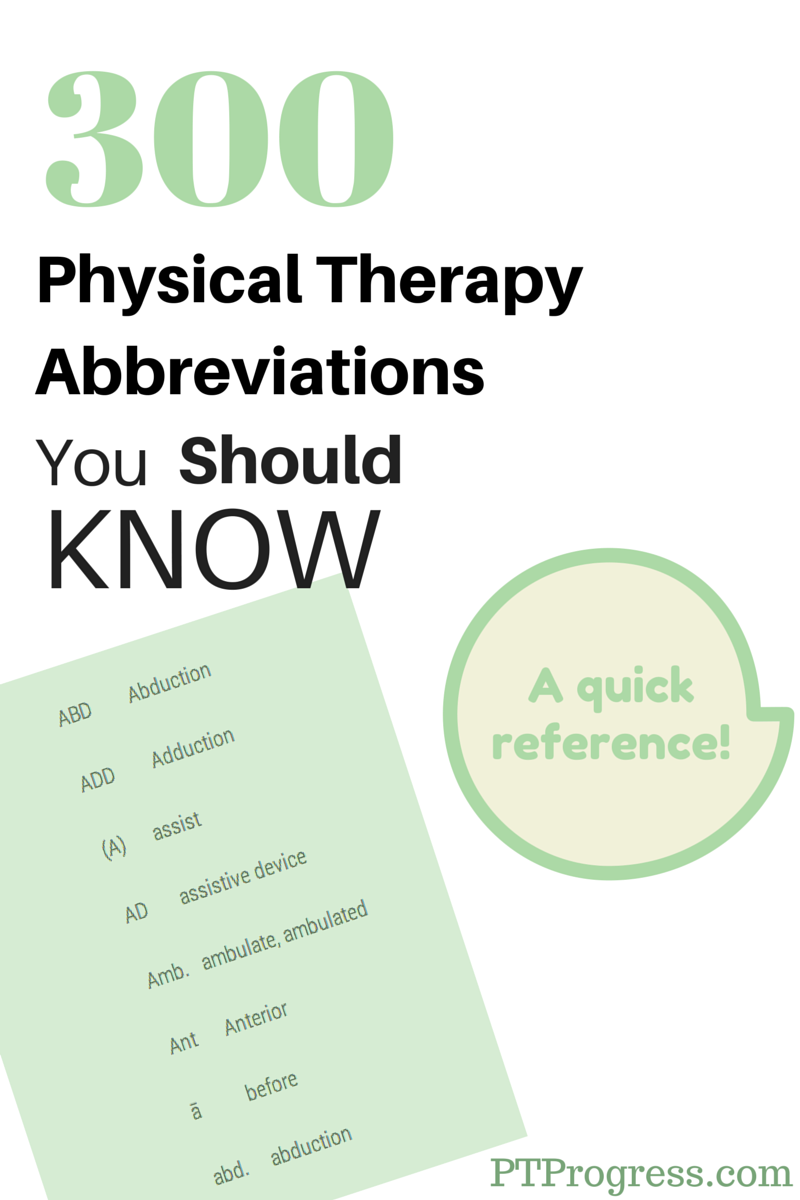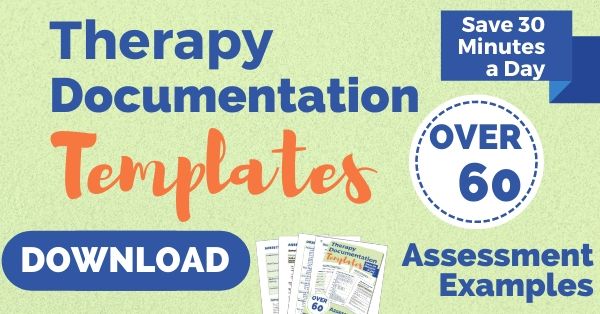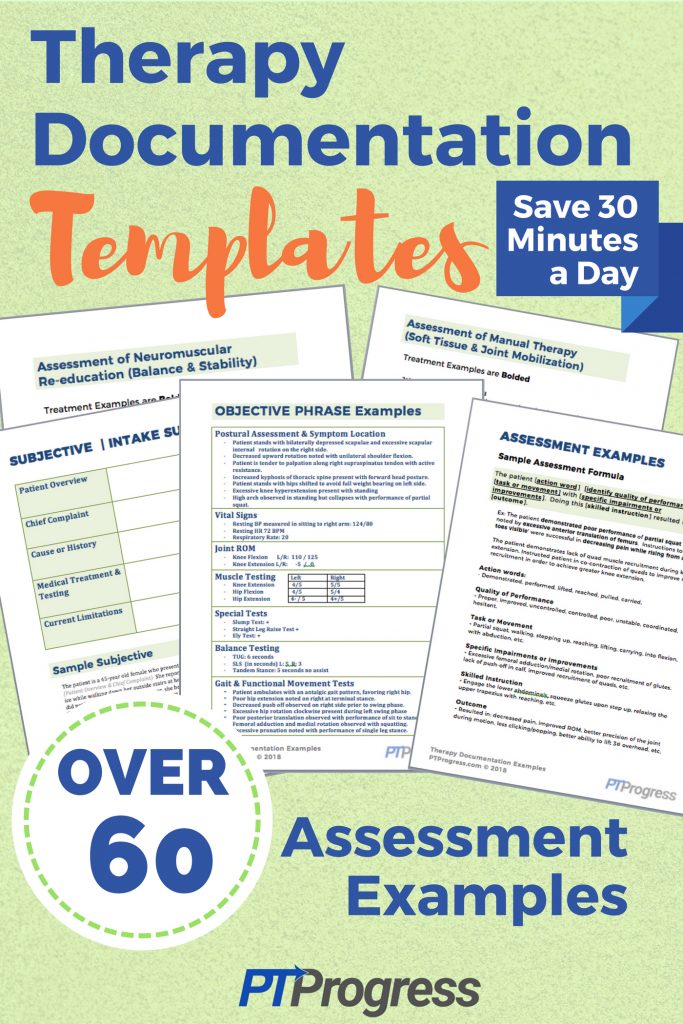
When Physical Therapists document the progress of a patient, it’s common to see medical abbreviations within the notes. For example, the Physical Therapy abbreviation SBA (stand by assist) or CGA (contact guard assist) are common PT medical abbreviations.
But sometimes our abbreviations can get a little confusing! As a Physical Therapist, I have to be careful with the pt medical abbreviation because lowercase pt should mean patient, while upper case PT refers to Physical Therapist.
While the APTA does not endorse a standard set of physical therapy abbreviations (maybe it should…) you can find plenty of resources that share common words that are shortened by PTs. This list is not all-inclusive or a ‘standard’ but it gives you an idea of what is commonly being used.
For student PT’s who are just starting in the clinic, it’s great to review this list in case you run into some language in the documentation that you’re not familiar seeing.
PT Documentation Guide
How I Saved 30 Minutes a Day on Documentation
When I finally learned how to document correctly, it saved me about 30 to 60 minutes a day.
These well-crafted documentation phrases save you time by providing you with inspiration on how to phrase the skill you provide to your patients.
You can copy and paste directly from the documentation PDF, and modify the phrases to fit your documentation style and to reflect the skilled treatment you’ve provided.
Common Physical Therapy Abbreviations
AAROM Active Assistive Range of Motion
ABD Abduction
ADD Adduction
(A) assist
AD assistive device
Amb. ambulate, ambulated
Ant Anterior
ā before
abd. abduction
ACL anterior cruciate ligament
ADL’s activities of daily living
Add. adduction
AFO ankle foot orthosis
@ at
AKA above knee amputee
ALS Amyotrophic Lateral Sclerosis
amb ambulate
Appt. appointment
AROM active range of motion
As tol As tolerated
A/P Anterior Posterior
(B) Bilateral
B/L Bilateral
BAPS Biomechanical Ankle Platform System
bed mob. bed mobility
bk back
BKA below knee amputation
BID Twice a day
BIW bi-weekly, twice weekly
BOS Base of support
BP Blood pressure
bpm Beats per minute
Bwd Backward
CA Cancer
cerv. cervical
CC Chief Complaint
CF Cystic Fibrosis
CGA Contact Guard Assist
CHF Congestive Heart Failure
CHI closed head injury
Cont. continue
COTA certifi ed occupational therapy assistant
COPD Chronic Obstructive Pulmonary Disease
C/o Complains of
COG Center of gravity
Cont Continue
CP coldpack, cerebral palsy
CPM Continuous passive motion
C/S cervical spine
CVA Cerebral Vascular Accident
CVD Cardio-Vascular Disease
CRPS Complex Regional Pain Syndrome
CP Cerebral Palsy
CTS Carpal Tunnel Syndrome
Cx. cancel, cancellation
dep., D dependent
Dexa Dexamethazone
DC discharge, discontinue
D/C Discharge
DDD Degenerative Disc Disease
DF dorsiflexion
Diag Diagonal
DIP Distal Interphalangeal Joint
DJD Degenerative Joint Disease
DM Diabetes Mellitus
DMD Duchenne Muscular Dystrophy
DME durable medical equipment
DOB Date of birth
DOI Date of injury
DOS Date of surgery
DVT Deep Vein Thrombosis
Dx Diagnosis
Eval. evaluation eversion
Ev. eversion
Equip. equipment
ER Emergency Room
E-stim Electrical Stimulation
EOB Edge of bed
Ex. exercise
Ext. extension
Ext. rot., ER external rotation
freq frequency
F, 3/5 fair (in reference to manual muscle testing)
FES Functional Electrical Stimulation
Flex. flexion
FCR Flexor Carpi Radialis
FCU Flexor Carpi Ulnaris
F/u Follow up
FWW Front wheeled walker
FWB full weight bearing
fwd forward
Fx. fracture
GH Gleno-Humeral
Gt. Trng. gait training
G, 4/5 good (in reference to manual muscle testing)
GMT gross muscle test
HA Headache
Hemi. hemiplegia, hemiparesis
HEP home exercise program
HHA home health aide
HKAFO hip knee ankle foot orthosis
HOB Head of bed
Hor Horizontal
HP hot pack
H/S Hamstring
HNP Herniated Nucleus Pulposus
HTN Hypertension
HVGS high voltage galvanic stimulation
HX history
H/o History of
I , Indep independent
IDDM insuline dependent diabetes mellitus
IE initial evaluation
IFC interferential current
IMS intramuscular stimulation
Inf Inferior
Int. rot., IR internal rotation
Inv. inversion
Ionto Iontophoresis
Isom isometric
ITB Ilio-tibial Band
Jt Joint
KAFO Knee ankle foot orthosis
L , L, Lt. left
LAQ long arc quad (exercise.)
Lat Lateral
Lats Latissimus Dorsi
LBP low back pain
LB lower body
LBQC large base quad cane
LCL Lateral Collateral Ligament
LE lower extremity
LQ lower quadrant
LTG long term goal
L/S Lumbar Spine
Max Maximum
MCL Medial Collateral Ligament
MCP Metacarpophalangeal Joint
Med Medial
MDL moderately limited
MENS microcurrent electrical nerve stimulator
MFR myofacial release
MI Myocardial Infarction
Min Minimum
M/L Medial Lateral
MFR Myofascial Release
MHP Moist Hot Pack
MKL markedly limited
mm. muscle
MMT manual muscle test
MNL minimally limited
Mob Mobilization
mod Moderate
MS Multiple Sclerosis
MSW medical social worker
MTP Metatarsophalangeal Joint
MVA Motor Vehicle Accident
Max. maximal
N, .5/5 normal (re: muscle strength)
NAGS Natural Apophyseal Glides
NBQC Narrow Based Quad Cane
NCV nerve conduction velocity
NIDDM non-insulin dependent diabetes mellitus
N/T numbness and tingling or not tested
NF No Fault
NMR Neuromuscular re-education
NWB non-weight bearing
NS No Show
OA Osteoarthritis
OOB Out of bed
OT occupational therapy/therapist
OTR registered occupational therapist
_
p after
PBall Physio-Ball
PD Parkinson’s Disease
P, 2/5 poor (re: muscle strength)
Pec Pectoral / Pectoralis
PCL Posterior Cruciate Ligament
PIP Proximal Interphalangeal Jt
PF plantar fl exion
PMH past medical history
Pn pain
PNF Proprioceptive Neuromuscular Facilitation
POC plan of care
P/A Posterior Anterior
PRE progressive resistive exercises
Post Posterior
Prec. Precautions
Prep. preparation
Prox Proximal
Pron Pronation
Phono Phonophoresis
PRN As needed
Pt. patient
PT physical therapy/therapist
PTA physical therapist assistant
P/u Push up
PVD Peripheral Vascular Disease
PWB partial weight bearing
Quad Quadriceps
QS Quadriceps Set
RA Rheumatoid Arthritis
R , R, rt right
Re recheck
Rec’d received
Rehab. rehabilitation
Reps. repetitions
Req/d. required
RGO reciprocating gait orthosis
ROM Range of Motion
Rot. rotation
r/o Rule out
RSD Reflex Sympathetic Dystrophy
RTC Rotator Cuff
RTW Return to work
Rx. treatment
RW Rolling Walker
SAQ short arc quad (exercise)
SB Sidebend
SBA standby assist
SBQC small base quad cane
SCI spinal cord injury
Script Prescription
SI, SIJ sacroiliac joint
Sh shoulder
S/L Sidelying
SLP speech-language pathologist
SLR Straight Leg Raise
SNAGS Sustained Natural Apophyseal Glides
SOB Shortness of Breath
S/p Status post
SPC Single point cane
SPT student P.T.
SPTA student P.T.A.
ST speech therapy
STG short term goals
STM Soft Tissue Mobilization
(S) Supervision
Sup Supination or Superior
SW Standard Walker
T-Band Theraband
T, 1/5 trace (re: muscle strength)
TA Therapeutic Activities
TBI Traumatic Brain Injury
TENS transcutaneous electrical nerve stimulator
THA total hip arthroplasty
THR total hip replacement
TIW three times per week
THA Total Hip Arthroplasty
THR Total Hip Replacement
Ther Ex Therapeutic Exercise
TIA Transient Ischemic Attack
TKA total knee arthroplasty
TKR total knee replacement
TLSO Thoracolumbosacal orthotic
TM treadmill
TMJ Temporomandibular Joint
Tol Tolerated
TTWB Toe Touch Weight Bearing
T/S Thoracic Spine
Tx Traction
UB upper body
UBE Upper Body Ergometer
UE upper extremity
UQ upper quadrant
US ultrasound
UV ultraviolet
VC verbal cues
VIC Verbalized informed consent
W/cm2 watts per centimeter squared
WB weight bearing
WBQC Wide based quad cane
WBAT weight bearing as tolerated
W/C Wheelchair
WFL within functional limits
WNL within normal limits
y/o Years old
// Bars Parallel Bars
4WW Four wheeled walker
_
s without
_
c with
1° primary
2° secondary
approx. approximately
# pound
(3 dots in a triangle) therefore
(Triangle) change
= equals
Z, 0/5 zero (re: muscle strength)
< Less Than
> Greater Than
1:1 One to one
‘ Foot or Feet
‘’ Inches
# Pounds
↑ Up, increased
↓ Down, decreased
√ Flexion
∕ Extension
↔ To and from
Do you see any common abbreviations that have been left out? Let us know in the comments and we’ll add them.
Here’s How I Saved 30 Minutes a Day on Documentation
When I finally learned how to document correctly, it saved me about 30 to 60 minutes a day.
These well-crafted documentation phrases save you time by providing you with inspiration on how to phrase the skill you provide to your patients.
You can copy and paste directly from the documentation PDF, and modify the phrases to fit your documentation style and to reflect the skilled treatment you’ve provided.



